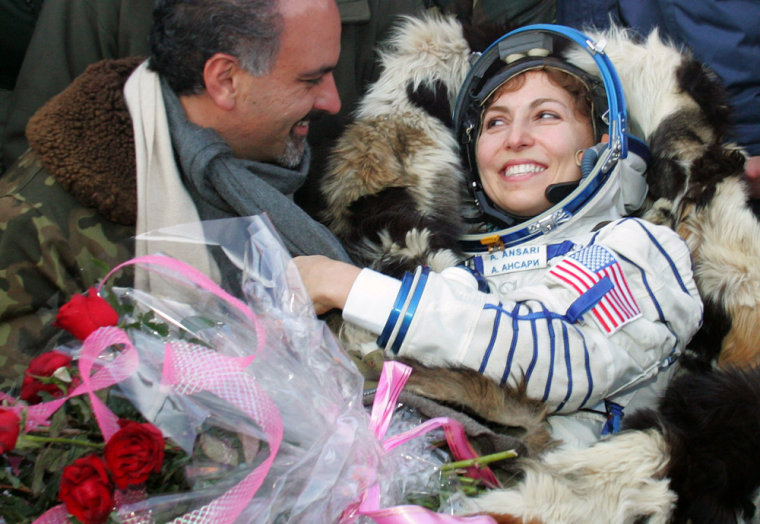The capsule carrying the first woman millionaire in space touched down Friday on the Kazakh steppe after a bone-jarring journey from the international space station.
Anousheh Ansari, Russian cosmonaut Pavel Vinogradov and U.S. astronaut Jeffrey Williams had left the station aboard a cramped Russian Soyuz capsule about three hours earlier. After the capsule entered Earth’s atmosphere, search-and-rescue teams in three planes and 12 helicopters tracked the trajectory and scrambled to help the crew out of the craft.
Officials monitoring the landing from Russia’s Mission Control outside Moscow applauded after confirming that the capsule had landed in the target zone around 56 miles (90 kilometers) north of Arkalyk, Kazakhstan, at 5:14 a.m. Moscow time (9:14 p.m. ET Thursday). The crew felt well, Mission Control said.
Video monitors at Mission Control showed Ansari smiling weakly as she sat in a chair surrounded by high grass after exiting the Soyuz. She was presented with a large bouquet of red roses. Vinogradov and Williams sat in chairs nearby. Temperatures hovered around 27 degrees Fahrenheit (-3 degrees Celsius).
“They brought me home safe and sound,” Ansari said. “I had a great experience.”
A surprise kiss
Ansari’s husband Hamid surprised her, coming up from behind her chair and planting a kiss on her face. Rescuers then picked up all three chairs and carried them to waiting helicopters for the flight to Kustanai, Kazakhstan, where they were to board a plane for the trip to the Russian cosmonauts’ training center at Star City outside Moscow.
They were accompanied by snails, worms and barley grown in experiments conducted aboard the orbiting station.
“Anousheh has done a good job — she’s one of the team,” Itar-Tass quoted Vinogradov as saying.
The space travelers underwent a quick medical evaluation through monitors attached to their bodies as soon as they exited the capsule. The information, transmitted to a nearby medical tent, was then sent to the U.S. space agency in Houston for analysis.
Last-minute passenger
Ansari, an Iranian-born American telecommunications entrepreneur, was a last-minute choice for the mission, which blasted off from the Russian manned space launch complex in Baikonur, Kazakhstan, on Sept. 18. Japanese businessman Daisuke Enomoto was scheduled to be on the launch, but he was scrubbed from the trip in late August for unspecified medical reasons.
The 40-year-old Ansari was the fourth person, and the first woman, to pay a reported $20 million for a trip to the international space station. Briton Helen Sharman in 1991 took a trip to Russia’s Mir station that she won through a contest.
Ansari’s two companions on the trip to the station, Russian Mikhail Tyurin and American Michael Lopez-Alegria, were staying aboard the station for a six-month stint along with German Thomas Reiter of the European Space Agency, who arrived aboard the space shuttle Discovery in July.
The return to Earth, though quick, can be physically taxing; the heavy deceleration once in Earth’s atmosphere — from about 500 mph to 180 mph (800 to 290 kilometers per hour) — inflicts severe G-forces on space explorers who have spent the previous weeks or months weightless. As it nears the ground, the Soyuz fires its engines to slow the descent again to about 3 mph (5 kilometers per hour).
In her native Iran, Ansari has become an inspiration to many women who chafe at the country’s male-dominated rule. Scores of women went to an observatory near Tehran last week to watch the space station streak across the sky at dawn.
In a blog about her space experiences, Ansari suggested that life aboard the crowded space station could be a model for reducing tensions among people and nations on the planet.
“It’s sort of like on Earth, if you think about it,” she wrote. “We are all connected to each other by living on the only habitable planet in the solar system; we have no place else to go, at least not for a while, so if we don’t get along and blow up everything and create a mess of our home, well guess what? We have to live with it.”
This report was supplemented by information from Reuters.
